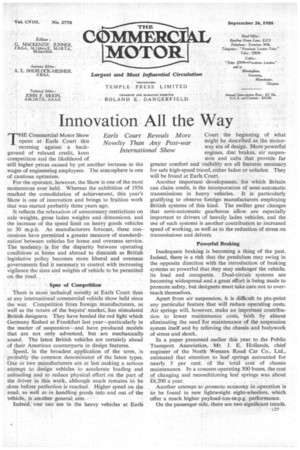innovation All the Way
Page 93

Page 94

If you've noticed an error in this article please click here to report it so we can fix it.
THE Commercial Motor Show opens at Earls Court this morning against a background of relaxed credit, keen competition and the likelihood of still higher prices caused by yet another increase in the wages of engineering employees. The atmosphere is one of cautious optimism.
For the operator, however, the Show is one of the most momentous ever held. Whereas the exhibition of 1956 marked the consolidation of achievement, this year's Show is one of innovation and brings to fruition work that was started probably three years ago.
It reflects the relaxation of unnecessary restrictions on axle• weights, gross laden weights and dimensions, and the increase of the speed limit on heavy goods vehicles to 30 m.p.h. As manufacturers forecast, these concessions have permitted a greater measure of standardization between vehicles for home and overseas service. The tendency is for the disparity between operating conditions at home and abroad to diminish as British legislative policy becomes more liberal and overseas governments find it necessary to control with increasing vigilance the sizes and weights of vehicle to be permitted on the road., .
Spur of Competition There is more technical novelty at Earls Court than at any international commercial vehicle show held since the war. Competition from foreign manufacturers, as well as the return of the buyers' market, has stimulated British designers. They have heeded the red light which Germany flashed at Frankfurt last year—particularly in the matter of suspension—and have produced models that are not only advanced, but are mechanically sound. The latest British vehicles are certainly ahead of their American counterparts in design features.
Speed, in the broadest application of the term, is probably the common denominator of the latest types. One or two manufacturers are at last making a serious attempt to design vehicles to accelerate loading and • unloading .and to reduce physical effort on the part of the driver in this work, although much remains to be done before perfection is reached. Higher Teed on the road, as well as in handling. goods into and out of the vehicle,. is another general_aim.
Indeed, 'one -earl see 'in the heavy vehicles at Earls Court the beginning of what might be described as the motorway era of design. More powerful engines, disc brakes, air suspension and cabs that provide far greater comfort and visibility are all features necessary for safe high-speed travel, either laden or unladen. They will be found at Earls Court.
Another important development, for which Britain can claim credit, is the incorporation of semi-automatic transmissions in heavy vehicles. It is particularly gratifying to observe foreign manufacturers employing British systems of this kind. The swifter gear changes that semi-automatic gearboxes allow are especially important to drivers of heavily laden vehicles, and the use of such systems is another contribution to increased speed of working, as well as to the reduction of stress on transmissions and drivers.
Powerful Braking Inadequate braking is becoming a thing of the past. Indeed, there is a risk that the pendulum may swing in the opposite direction with the introduction of braking systems so powerful that they may endanger the vehicle, its load and occupants. Dual-circuit systems are becoming widespread and a great effort is being made to promote safety, but designers must take care not to overreach themselves.
Apart from air suspension, it is difficult to pin-point any particular feature that will reduce operating costs. Air springs will, however, make an important contribution to lower maintenance costs, both by almost eliminating the need for maintenance of the suspension system itself and by relieving the chassis and bodywork of stress and shock.
In a paper presented earlier this year to the Public Transport Association, Mr. j. E. Hollands, chief engineer of the North Western Road Car Co., Ltd., estimated that attention to leaf springs accounted for nearly 5 per cent. of the total cost of chassis maintenance. In a concern operating 500 buses, the cost of changing and reconditioning leaf springs was about £6,200 a year.
Another attempt to promote economy in operation is to be found in new, lightweight eight-wheelers, which -offer a much higher payload-ton-m.p.g. performance.
On the passenger side, there are two significant trends. One is towards front entrances for double-deckers. They are almost essential in high-capacity vehicles seating 70 or more people, for the driver must share with the conductor the responsibility of taking care of passengers in boarding and alighting.
The other trend is represented by the host of new 12seaters, which are being produced as a result of the relaxation in the Conditions of Fitness Regulations for small buses intended for use on rural services. Whether they will in fact be employed for this work is doubtful, but it is likely that they will be used to an increasing extent for private hire.
In every part of Earls Court the visitor will find evidence of virility—on the stands of tyre, accessory and component and service-equipment manufacturers in the galleries, and in displays by trailer makers and bodybuilders, as well as by chassis manufacturers, on the ground floor.












































































































































































































































































































































